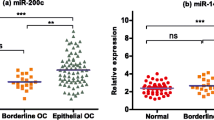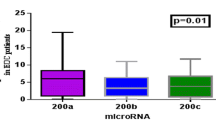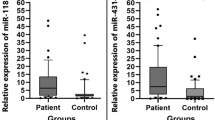Abstract
Epithelial ovarian cancer (EOC) is the most lethal cause of morbidity and mortality worldwide. miRNA deregulation evinces a remarkable role in ovarian cancer tumorigenesis. miRNA-199a (miR-199a) is known to be involved in cancer development and progression. Although miR-199a has been studied in various cell types, its correlation with clinicopathological features in EOC has not been documented. In this study, we identified the clinicopathological hallmarks which might be perturbed due to the downregulation of serum miR-199a in EOC. Seventy serum samples from histopathologically confirmed EOC patients and 70 controls were collected. Total RNA from serum was isolated by Trizol method, polyadenylated and reverse transcribed into cDNA. Expression level of miR-199a was detected by using miRNA qRT-PCR. Relative expression was determined with matched controls using U6 snRNA as reference. Level of miR-199a expression was compared with distinct clinicopathological features. Expression of miR-199a was found to be significantly downregulated in comparison with matched normal controls. The expression level of miR-199a was found to be significantly associated with tumor stage, lymph node metastasis, and distal metastasis. Receiver operating characteristic (ROC) curve for diagnostic potential yielded significant area under the curve (AUC) with a considerable sensitivity and specificity. ROC curves for prognosis yielded significant AUCs for histological grade, distal metastasis, lymph node status, and survival. Our findings suggest that miR-199a downregulation might be a potential indicator for disease progression promoting the aggressive tumor progression and be identified as a diagnostic marker to predict the prognosis and survival in EOC patients.





Similar content being viewed by others
Abbreviations
- EOC:
-
Epithelial ovarian cancer
- miR:
-
microRNA
- qRT-PCR:
-
Quantitative real-time polymerase chain reaction
References
Gadducci A, Sergiampietri C, Lanfredini N, Guiggi I. Micro-RNAs and ovarian cancer: the state of art and perspectives of clinical research. Gynecol Endocrinol Off J Int Soc Gynecol Endocrinol. 2014;30(4):266–71.
Iorio MV, Visone R, Di Leva G, Donati V, Petrocca F, Casalini P, et al. MicroRNA signatures in human ovarian cancer. Cancer Res. 2007;67(18):8699–707.
Guo W, Qiu Z, Wang Z, Wang Q, Tan N, Chen T, et al. MiR-199a-5p is negatively associated with the malignancies and regulates glycolysis and lactate production by targeting hexokinase 2 in liver cancer. Hepatol Baltim Md. 2015 Jun 5.
Murakami Y, Yasuda T, Saigo K, Urashima T, Toyoda H, Okanoue T, et al. Comprehensive analysis of microRNA expression patterns in hepatocellular carcinoma and non-tumorous tissues. Oncogene. 2006;25(17):2537–45.
Ichimi T, Enokida H, Okuno Y, Kunimoto R, Chiyomaru T, Kawamoto K, et al. Identification of novel microRNA targets based on microRNA signatures in bladder cancer. Int J Cancer J Int Cancer. 2009;125(2):345–52.
Kim S, Lee UJ, Kim MN, Lee E-J, Kim JY, Lee MY, et al. MicroRNA miR-199a* regulates the MET proto-oncogene and the downstream extracellular signal-regulated kinase 2 [ERK2]. J Biol Chem. 2008;283(26):18158–66.
Ford CE, Lau SK, Zhu CQ, Andersson T, Tsao MS, Vogel WF. Expression and mutation analysis of the discoidin domain receptors 1 and 2 in non-small cell lung carcinoma. Br J Cancer. 2007;96(5):808–14.
Johnson JD, Edman JC, Rutter WJ. A receptor tyrosine kinase found in breast carcinoma cells has an extracellular discoidin I-like domain. Proc Natl Acad Sci U S A. 1993;90(22):10891.
Laval S, Butler R, Shelling AN, Hanby AM, Poulsom R, Ganesan TS. Isolation and characterization of an epithelial-specific receptor tyrosine kinase from an ovarian cancer cell line. Cell Growth Differ Mol Biol J Am Assoc Cancer Res. 1994;5(11):1173–83.
Shen Q, Cicinnati VR, Zhang X, Iacob S, Weber F, Sotiropoulos GC, et al. Role of microRNA-199a-5p and discoidin domain receptor 1 in human hepatocellular carcinoma invasion. Mol Cancer. 2010;9:227.
Matsumura T, Sugimachi K, Iinuma H, Takahashi Y, Kurashige J, Sawada G, et al. Exosomal microRNA in serum is a novel biomarker of recurrence in human colorectal cancer. Br J Cancer. 2015 Jun 9.
Ge Q, Shen Y, Tian F, Lu J, Bai Y, Lu Z. Profiling circulating microRNAs in maternal serum and plasma. Mol Med Rep. 2015 Jun 3.
Yamada A, Horimatsu T, Okugawa Y, Nishida N, Honjo H, Ida H, et al. Serum miR-21, miR-29a and miR-125b are promising biomarkers for the early detection of colorectal neoplasia. Clin Cancer Res Off J Am Assoc Cancer Res. 2015 Jun 2.
Cho WC. Exploiting the therapeutic potential of microRNAs in human cancer. Expert Opin Ther Targets. 2012;16:345350.
Calin GA, Croce CM. MicroRNA-cancer connection: the beginning of a new tale. Cancer Res. 2006;66:7390–4.
Brenner B, Hoshen MB, Purim O, et al. MicroRNAs as a potential prognostic factor in gastric cancer. World J Gastroenterol. 2011;17:3976–85.
Wan D, He S, Xie B, et al. Aberrant expression of miR-199a-3p and its clinical significance in colorectal cancers. Med Oncol. 2013;30:378.
Feber A, Xi L, Pennathur A, et al. MicroRNA prognostic signature for nodal metastases and survival in esophageal adenocarcinoma. Ann Thorac Surg. 2011;91:1523–30.
Ballabio E, Mitchell T, van Kester MS, et al. MicroRNA expression in Sezary syndrome: identification, function, and diagnostic potential. Blood. 2010;116:1105–13.
Hou J, Lin L, Zhou W, et al. Identification of miRNomes in human liver and hepatocellular carcinoma reveals miR-199a/b-3p as therapeutic target for hepatocellular carcinoma. Cancer Cell. 2011;19:232–43.
Henry JC, Park JK, Jiang J, et al. miR-199a-3p targets CD44 and reduces proliferation of CD44 positive hepatocellular carcinoma cell lines. Biochem Biophys Res Commun. 2010;403:120–5.
Fornari F, Milazzo M, Chieco P, Negrini M, Calin GA, Grazi GL, et al. MiR-199a-3p regulates mTOR and c-Met to influence the doxorubicin sensitivity of human hepatocarcinoma cells. Cancer Res. 2010;70:5184–93.
Duan Z, Choy E, Harmon D, et al. MicroRNA-199a-3p is downregulated in human osteosarcoma and regulates cell proliferation and migration. Mol Cancer Ther. 2011;10:1337–45.
Ichimi T, Enokida H, Okuno Y, et al. Identification of novel microRNA targets based on microRNA signatures in bladder cancer. Int J Cancer. 2009;125:345–52.
Qu Y, Huang X, Li Z, Liu J, Wu J, Chen D, et al. miR-199a-3p inhibits aurora kinase A and attenuates prostate cancer growth: new avenue for prostate cancer treatment. Am J Pathol. 2014;184:1541–9.
Minna E, Romeo P, De Cecco L, et al. miR-199a-3p displays tumour suppressor functions in papillary thyroid carcinoma. Oncotarget. 2014;5:2513–28.
Nam EJ, Yoon H, Kim SW, et al. MicroRNA expression profiles in serous ovarian carcinoma. Clin Cancer Res. 2008;14:2690–5.
Chen R, Alvero AB, Silasi DA, et al. Regulation of IKKbeta by miR-199a affects NF-kappaB activity in ovarian cancer cells. Oncogene. 2008;27:4712–23.
Cheng W, Liu T, Wan X, Gao Y, Wang H. MicroRNA-199a targets CD44 to suppress the tumorigenicity and multidrug resistance of ovarian cancer-initiating cells. FEBS J. 2012;279:2047–59.
Joshi HP, Subramanian IV, Schnettler EK, et al. Dynamin 2 along with microRNA-199a reciprocally regulate hypoxia-inducible factors and ovarian cancer metastasis. Proc Natl Acad Sci U S A. 2014;111:5331–6.
Acknowledgments
We gratefully acknowledge the assistance of University Grants Commission for supporting this work.
Author information
Authors and Affiliations
Corresponding author
Ethics declarations
Conflicts of interest
None.
Informed consent
Written informed consent was obtained from all individual participants included in the study.
Ethical approval
All procedures performed in this study involving human participants were approved and were in accordance with the institutional ethics committee at Maulana Azad Medical College, New Delhi.
Rights and permissions
About this article
Cite this article
Zuberi, M., Khan, I., Gandhi, G. et al. The conglomeration of diagnostic, prognostic and therapeutic potential of serum miR-199a and its association with clinicopathological features in epithelial ovarian cancer. Tumor Biol. 37, 11259–11266 (2016). https://doi.org/10.1007/s13277-016-4993-2
Received:
Accepted:
Published:
Issue Date:
DOI: https://doi.org/10.1007/s13277-016-4993-2




